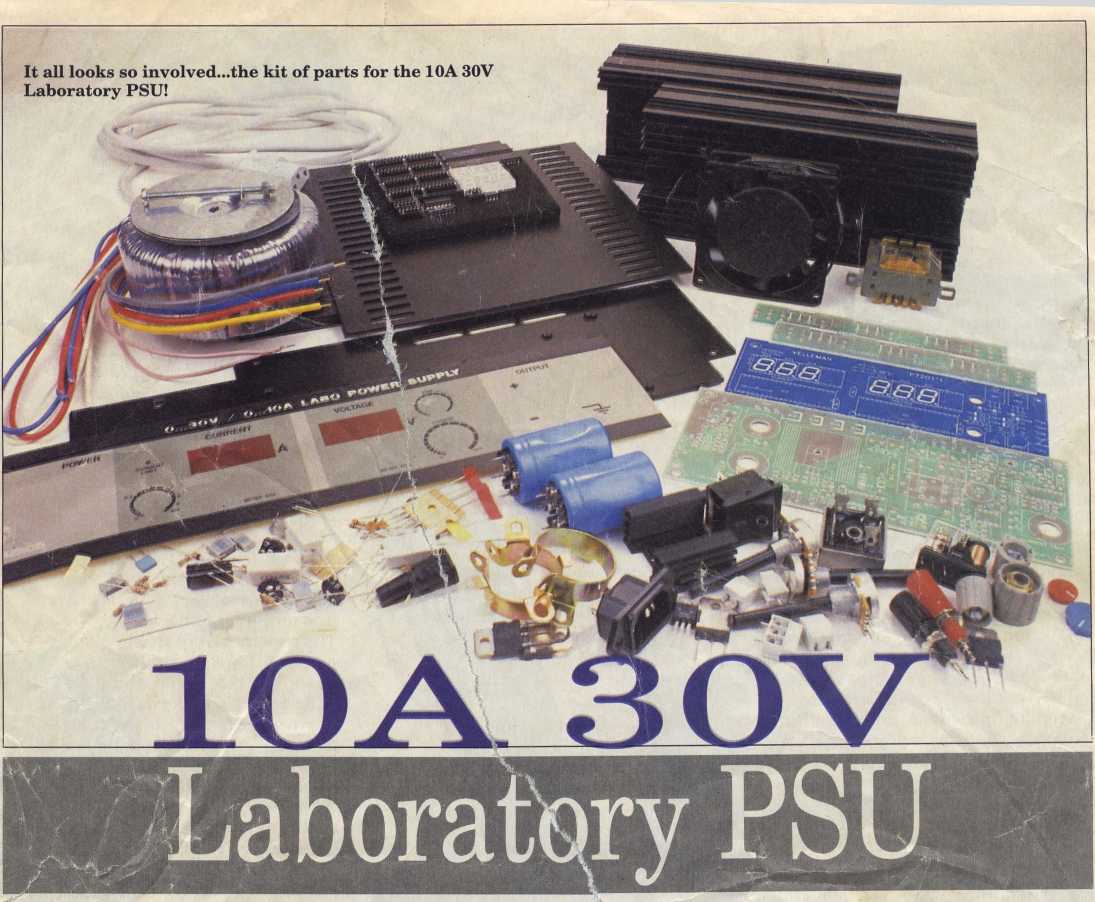File0001 (2)


Text by Martin Pipę
FEATURES
* Digital voltage meter: 3 digit * Output voltage variable from 0 to * Oui^it short circuit protected
0-lV accuracy +30V (Fine adjustment over IV) * MaximuuT^r.trutnpp-Je 0-5V rms
* Digital ampere meter: 3 digit * Yariable current limit from Oto 10A * Cooling fan for prolonged usnge
OfOlA accuracy
* LED current limit indicator
at fuli power
Applications
# Laboratories and test benches *Powering mobile radio eąuipment
#Precision charging of batterics
This extremely flexible laboratory power supply unit (PSU) is capable of sourcing well-regu-lated DC voltages of up to 30V at currents of up to 8A continuous, 10A peak. As a result, there is a wide rangę of potential applications for the hobbyist, service department and edu-cational institutions. For example, it is ideał for the testing of prototypes; in addition to the sheer power output available, there is a current-limiting function-ideał for trying out your morę delicate circuits. This function, and the robust naturę of this unit, makes it an ideał choice for servicing DC eąuipment (e.g., portable audio and video eąuipment) and for college workbenches. In addition, this piece of eąuipment is ideał for the running of CB and amateur radio eąuipment,
and even the charging of batteries; lead-acid packs in ‘constant voltsige’ modę, and Ni-Cd cells in ‘constant current’ modę.
Circuit Description
1. Control PCB
(Refer to circuit diagram of Figurę! )• IC2 & 3 are pA723 voltage/currt'nt
regulators. IC2 is used to set the output voltage; R6 providing feedhack to compensate for the voltage drop across T2, R16, T3 and R31. A frac-tion of the output voltage determined by R5 and R23 is supplied to IC2 as feedback. IC3 is responsible for current-limiting; its operation is very interesting. A user-set reference volt-age (the ‘current limit’) is derived frotn the IC3’s on-chip reference via ‘ RVl/2/3, R18, R27 and R28. This is compared to the voltage developed across R37 to R40 (which are situated between output ground and the reference ground); if it exceeds the user-set reference, then the error voltage pro-duced by IC3 will be sufficient to for-ward-bias the LED, in doing so it will turn on the current-limiting transis-tor integral to voltage regulator IC2.
40
U aplin Magazine October' 992
Wyszukiwarka
Podobne podstrony:
view2 Digital Fręuency Meter WWW.IKALaGIC.CDM HOME MADĘ BY IBRAHIM KAMAL <ika@ikalogic.com>
C..A. Mascardi (Orał discussion) Few comments can be added to the contributions by Martinetti and Di
THE RESUSC1TAT10M C0UNC1L UK PRESEHTSLIFESAUERANINTERACTIVE FILM BY MARTIN PERCY PWOUCEDBY UNITęyyjT
C..A. Mascardi (Orał discussion) Few comments can be added to the contributions by Martinetti and Di
45272 panel (12) Digital Power Meter DPM-1QQ • MtASURt CON. IN Curren! fiow quj • GND • www pcrt&
52010 PhotoMerge PhotoMerge descriptionAn easy to use tool for text inserting into your digital phot
Guidelines for A uthors 171 Cite references in the text by name of the author(s) a
art 09 01 Story and photos by Martin Donnon TECH TQRQUEMild and Wild CA18s One of the morę common ca
voltages ranging from —6 to —18 volts d.c.—coupled with a d.c.-d.c. converter for obtaining hig
Estimation of Horizontal Accuracy of the Large-Scale Digital Maps 43 lyzed topographic points obtain
132 and especially by the presence in their waters of Chemical compounds flowing from the immcdiate
0106908575c071ff4508349b7e8b07e7 Lewiston Area Riverview Inn Dinę by the riverside in a truły cozy s
więcej podobnych podstron